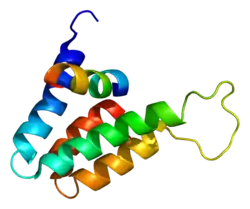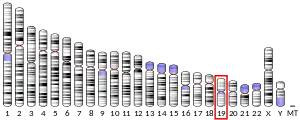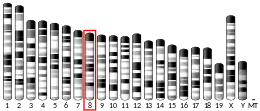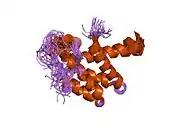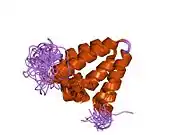SIN3B
Paired amphipathic helix protein Sin3b is a protein that in humans is encoded by the SIN3B gene.[5][6]
Interactions
SIN3B has been shown to interact with HDAC1,[7][8] Zinc finger and BTB domain-containing protein 16,[9] SUDS3[10] and IKZF1.[8][11]
See also
References
- GRCh38: Ensembl release 89: ENSG00000127511 - Ensembl, May 2017
- GRCm38: Ensembl release 89: ENSMUSG00000031622 - Ensembl, May 2017
- "Human PubMed Reference:". National Center for Biotechnology Information, U.S. National Library of Medicine.
- "Mouse PubMed Reference:". National Center for Biotechnology Information, U.S. National Library of Medicine.
- Ishikawa K, Nagase T, Suyama M, Miyajima N, Tanaka A, Kotani H, Nomura N, Ohara O (Jun 1998). "Prediction of the coding sequences of unidentified human genes. X. The complete sequences of 100 new cDNA clones from brain which can code for large proteins in vitro". DNA Research. 5 (3): 169–76. doi:10.1093/dnares/5.3.169. PMID 9734811.
- "Entrez Gene: SIN3B SIN3 homolog B, transcription regulator (yeast)".
- Zhang Y, Ng HH, Erdjument-Bromage H, Tempst P, Bird A, Reinberg D (Aug 1999). "Analysis of the NuRD subunits reveals a histone deacetylase core complex and a connection with DNA methylation". Genes & Development. 13 (15): 1924–35. doi:10.1101/gad.13.15.1924. PMC 316920. PMID 10444591.
- Koipally J, Renold A, Kim J, Georgopoulos K (Jun 1999). "Repression by Ikaros and Aiolos is mediated through histone deacetylase complexes". The EMBO Journal. 18 (11): 3090–100. doi:10.1093/emboj/18.11.3090. PMC 1171390. PMID 10357820.
- David G, Alland L, Hong SH, Wong CW, DePinho RA, Dejean A (May 1998). "Histone deacetylase associated with mSin3A mediates repression by the acute promyelocytic leukemia-associated PLZF protein". Oncogene. 16 (19): 2549–56. doi:10.1038/sj.onc.1202043. PMID 9627120.
- Alland L, David G, Shen-Li H, Potes J, Muhle R, Lee HC, Hou H, Chen K, DePinho RA (Apr 2002). "Identification of mammalian Sds3 as an integral component of the Sin3/histone deacetylase corepressor complex". Molecular and Cellular Biology. 22 (8): 2743–50. doi:10.1128/MCB.22.8.2743-2750.2002. PMC 133736. PMID 11909966.
- Koipally J, Georgopoulos K (Aug 2002). "A molecular dissection of the repression circuitry of Ikaros". The Journal of Biological Chemistry. 277 (31): 27697–705. doi:10.1074/jbc.M201694200. PMID 12015313.
Further reading
- Ayer DE, Lawrence QA, Eisenman RN (Mar 1995). "Mad-Max transcriptional repression is mediated by ternary complex formation with mammalian homologs of yeast repressor Sin3". Cell. 80 (5): 767–76. doi:10.1016/0092-8674(95)90355-0. PMID 7889570. S2CID 8749951.
- David G, Alland L, Hong SH, Wong CW, DePinho RA, Dejean A (May 1998). "Histone deacetylase associated with mSin3A mediates repression by the acute promyelocytic leukemia-associated PLZF protein". Oncogene. 16 (19): 2549–56. doi:10.1038/sj.onc.1202043. PMID 9627120.
- Koipally J, Renold A, Kim J, Georgopoulos K (Jun 1999). "Repression by Ikaros and Aiolos is mediated through histone deacetylase complexes". The EMBO Journal. 18 (11): 3090–100. doi:10.1093/emboj/18.11.3090. PMC 1171390. PMID 10357820.
- Naruse Y, Aoki T, Kojima T, Mori N (Nov 1999). "Neural restrictive silencer factor recruits mSin3 and histone deacetylase complex to repress neuron-specific target genes". Proceedings of the National Academy of Sciences of the United States of America. 96 (24): 13691–6. doi:10.1073/pnas.96.24.13691. PMC 24126. PMID 10570134.
- Spronk CA, Tessari M, Kaan AM, Jansen JF, Vermeulen M, Stunnenberg HG, Vuister GW (Dec 2000). "The Mad1-Sin3B interaction involves a novel helical fold". Nature Structural Biology. 7 (12): 1100–4. doi:10.1038/81944. PMID 11101889. S2CID 12451972.
- Spronk CA, Jansen JF, Tessari M, Kaan AM, Aelen J, Lasonder E, Stunnenberg HG, Vuister GW (Apr 2001). "Sequence-specific assignment of the PAH2 domain of Sin3B free and bound to Mad1". Journal of Biomolecular NMR. 19 (4): 377–8. doi:10.1023/A:1011262214741. PMID 11370785. S2CID 31789681.
- Alland L, David G, Shen-Li H, Potes J, Muhle R, Lee HC, Hou H, Chen K, DePinho RA (Apr 2002). "Identification of mammalian Sds3 as an integral component of the Sin3/histone deacetylase corepressor complex". Molecular and Cellular Biology. 22 (8): 2743–50. doi:10.1128/MCB.22.8.2743-2750.2002. PMC 133736. PMID 11909966.
- Rayman JB, Takahashi Y, Indjeian VB, Dannenberg JH, Catchpole S, Watson RJ, te Riele H, Dynlacht BD (Apr 2002). "E2F mediates cell cycle-dependent transcriptional repression in vivo by recruitment of an HDAC1/mSin3B corepressor complex". Genes & Development. 16 (8): 933–47. doi:10.1101/gad.969202. PMC 152357. PMID 11959842.
- Koipally J, Georgopoulos K (Aug 2002). "A molecular dissection of the repression circuitry of Ikaros". The Journal of Biological Chemistry. 277 (31): 27697–705. doi:10.1074/jbc.M201694200. PMID 12015313.
- Yang L, Mei Q, Zielinska-Kwiatkowska A, Matsui Y, Blackburn ML, Benedetti D, Krumm AA, Taborsky GJ, Chansky HA (Feb 2003). "An ERG (ets-related gene)-associated histone methyltransferase interacts with histone deacetylases 1/2 and transcription co-repressors mSin3A/B". The Biochemical Journal. 369 (Pt 3): 651–7. doi:10.1042/BJ20020854. PMC 1223118. PMID 12398767.
- Petrie K, Guidez F, Howell L, Healy L, Waxman S, Greaves M, Zelent A (May 2003). "The histone deacetylase 9 gene encodes multiple protein isoforms". The Journal of Biological Chemistry. 278 (18): 16059–72. doi:10.1074/jbc.M212935200. PMID 12590135.
- Wysocka J, Myers MP, Laherty CD, Eisenman RN, Herr W (Apr 2003). "Human Sin3 deacetylase and trithorax-related Set1/Ash2 histone H3-K4 methyltransferase are tethered together selectively by the cell-proliferation factor HCF-1". Genes & Development. 17 (7): 896–911. doi:10.1101/gad.252103. PMC 196026. PMID 12670868.
- Dugast-Darzacq C, Pirity M, Blanck JK, Scherl A, Schreiber-Agus N (Nov 2004). "Mxi1-SRalpha: a novel Mxi1 isoform with enhanced transcriptional repression potential". Oncogene. 23 (55): 8887–99. doi:10.1038/sj.onc.1208107. PMID 15467743.
- Rampalli S, Pavithra L, Bhatt A, Kundu TK, Chattopadhyay S (Oct 2005). "Tumor suppressor SMAR1 mediates cyclin D1 repression by recruitment of the SIN3/histone deacetylase 1 complex". Molecular and Cellular Biology. 25 (19): 8415–29. doi:10.1128/MCB.25.19.8415-8429.2005. PMC 1265755. PMID 16166625.
- Xu Y, Sengupta PK, Seto E, Smith BD (Apr 2006). "Regulatory factor for X-box family proteins differentially interact with histone deacetylases to repress collagen alpha2(I) gene (COL1A2) expression". The Journal of Biological Chemistry. 281 (14): 9260–70. doi:10.1074/jbc.M511724200. PMC 1434794. PMID 16464847.
External links
- SIN3B+protein,+human at the US National Library of Medicine Medical Subject Headings (MeSH)
This article incorporates text from the United States National Library of Medicine, which is in the public domain.
This article is issued from Wikipedia. The text is licensed under Creative Commons - Attribution - Sharealike. Additional terms may apply for the media files.
